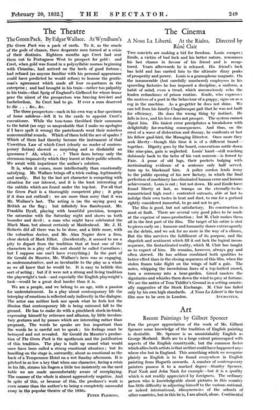Art
Recent Paintings by Gilbert Spencer
Foa the proper appreciation of the work of Mr. Gilbert Spencer some knowledge of the tradition of English painting is desirable. Mr. Spencer is as unmistakably English as George Morland. Both are to a large extent preoccupied with aspects of the English countryside, but the common factor which allies both artists is that neither could have happened any- where else but in England. This something which we recognize plainly as English is to be found everywhere in English painting from Hogarth onwards. A number of contemporary painters possess it to a marked degree—Stanley Spencer, Paul Nash and John Nash for example—but it is a quality which is not readily appreciated by foreigners. The ordinary person who is knowledgeable about pictures in this country has little difficulty in adjusting himself to the various national, or indeed international, idiosyncrasies of the schools of other countries, but in this he is, I am afraid, alone. Continental judges of the work of the British school are apt to be captions critics. Indeed, if one takes a broad view, Constable, and to a more limited degree, Turner, are the only British artists who are accepted by Continental critics. It is a commonplace to regard the British school as a provincial school, and I am prepared to admit that there is a lot to be said for this view, but, at-the same time„-it_must be emphasized that the term " provincial ". carries with it nothing derogatory. All our great painters from Hogarth through Gainsborough and Constable and Turner to John have been in a sense provincial painters. There is, however, a certain integrity of outlook about English " provincial " painters which is not to'-be despised. Their dress may be homespun, but the quality of the cloth is excellent.
Mr. Gilbert Spencer's exhibition at the Goupil Gallery is English of the English. At the same time I would hazard that it would be incomprehensible to an intelligent foreign critic. His principal painting, The Cotswold Farm, is partly a symbolic synthesis of the country life of England that is passing so rapidly and partly a statement of facts—a catalogue of objects connected with agriculture which are to be found in any unmodernised form. The whole is arranged in a rhythmic pattern of form and colour which is almost entirely successful. There is a certain similarity between it and Work, by F. Madox Brown, which spends its time alternately between Birmingham and the Tate Gallery. Other pictures which are noteworthy in this exhibition are Blackmore Vale, a particularly sympathetic landscape of the plain which lies behind the Dorset Heights : Wimborne, Lansdowne Crescent, Meadle and Thunder Clouds. In the two years which have passed since Mr. Spencer's last exhibition, there has been a great develop- ment in his work. His landscapes have become more subtle. His England still is rather a sunless England—a country of green trees and grey weather—but that is after all an England that those of us who are country dwellers know and love the







































 Previous page
Previous page